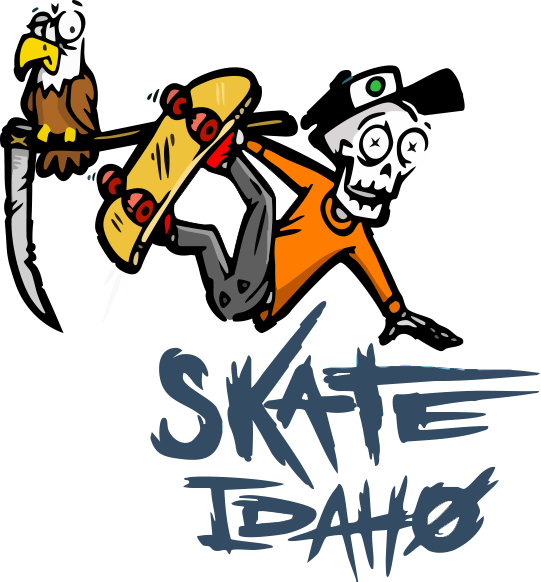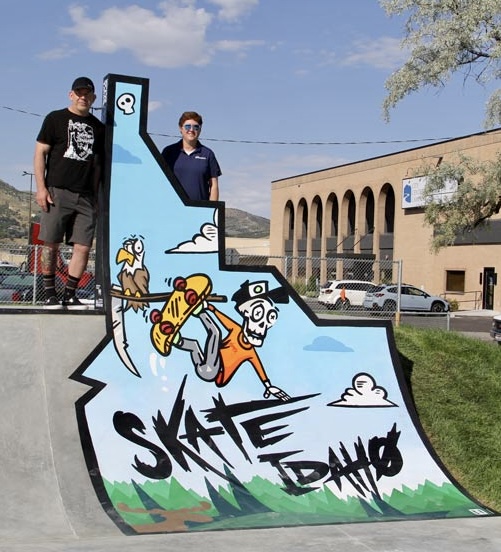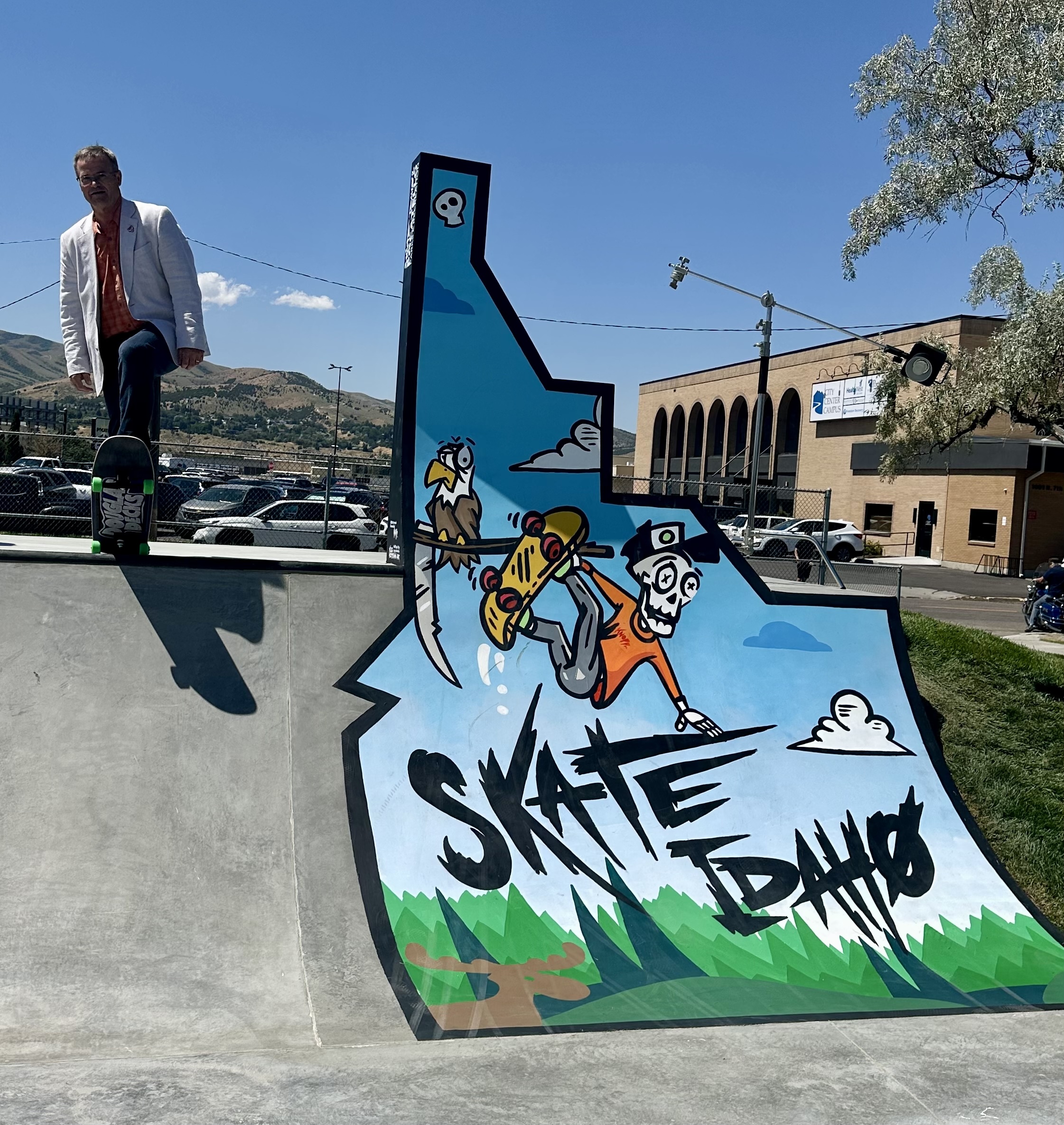Skateboarding isn’t just about ramps and rails — it’s about building community, listening to youth, and designing public spaces that reflect the people who use them. That’s why we’re proud to launch Dropping In with Parks Director Anne Butler, a new spotlight on the partnerships, process, and people behind Optimist Skatepark.
In this series, Anne shares what it takes to turn ideas into action — from navigating city logistics to empowering skaters to shape their own space. You’ll hear how collaboration with Skate Idaho, Councilman Nichols, and local families made this one of the most inclusive park projects in city history. And you’ll see how thoughtful design, open dialogue, and community care can transform a patch of land into a place where everyone belongs.
So roll in, listen up, and get inspired by what happens when parks leadership drops in with the people who make skate culture thrive.
Opening
Skate Idaho: Optimist Skatepark has quickly become a local favorite. From your perspective, as parks director, what does this space represent for the community?
Anne Butler: I think it’s a section of the community that’s underserved. In Ross Park, we have a skate park—it’s definitely showing its age. But until the excitement started growing around Optimist Skatepark. I don’t think many people realized how many individuals are actually underserved by this niche. I didn’t see it or understand it myself. I mean, I’ve been working with you and others, but that’s really just a small part of your larger community that I don’t always see. So I think the biggest takeaway is that this is a much larger group than we had anticipated.
Behind the Build
Skate Idaho: What did it take from the parks department to help bring Optimist Skatepark to life, from planning to construction?
Anne Butler: Fortunately for me, we had a lot of people involved in the process who are much smarter than I am. Between Councilman Nichols, you, and others who skate regularly, we had a solid team. I also brought in our city’s procurement team—they don’t skate, but they know a lot about Sourcewell and contract procurement. Councilman Nichols helped us review skatepark vendors he was familiar with, so we started with Sourcewell and began interviewing vendors from there.
We didn’t have to go out to bid with all the technical specs, because we didn’t yet know exactly what the skatepark should look like. We interviewed three vendors, and once we identified the one we wanted to move forward with, that’s when we brought in the broader community to help shape the design. We let the people who skate choose the features they wanted.
At that point, the project started to come back to the Parks Department. It really wasn’t ours until the administrative work was done. I was involved throughout, but our parks crews didn’t really have a role until after construction. That’s when we started looking at things like reassembling the irrigation system, keeping water off the park while still getting the grass to grow, and digging out the retention pond. They’ll also be involved in building the bathrooms and other follow-up work.
So I’d say it started as an administrative project at the city level and gradually transitioned into construction. We were fortunate to work with a vendor that specializes in this kind of project—it’s a niche, and we relied on their expertise to make sure it was built and built right.
Skate Idaho: Were there any unique challenges or creative solutions your team had to navigate during the build?
Anne Butler: We had a few elevation issues at the entrance. We wanted to make sure it was ADA accessible, and I think we accomplished that at the main entrance—right there at the circle near the bug (city logo)—where you can walk or roll in.
Down by the stairs, there wasn’t supposed to be a stair initially, but the elevations worked out that way, and I think it turned out fine. There are always a few things in every project that don’t go exactly as planned or envisioned, and that was probably the biggest one.
Just a few unexpected things, but overall, it’s been good. I’m sure there will still be a few more surprises—something that doesn’t weather well, or something that just isn’t quite right that we’ll need to address.
Skate Idaho: How did collaboration with Skate Idaho, city officials, and contractors shape the outcome?
Anne Butler: You know, that’s really the only way it happens. Our department didn’t bring any specific expertise to the table—what we did was bring groups together to collaborate. Everyone in this department enjoys doing something recreationally, and I’ve got some parks staff who like to skate and have enjoyed the skatepark.
But overall, the expertise didn’t come from within. It came from Skate Idaho, Councilman Nichols, others who shared what they know, and the vendor who brought their professional experience. We simply facilitated that process.
Community Impact
Skate Idaho: How have you seen the park being used since opening by skaters, families, or even passersby?
Anne Butler: You know, it’s constantly busy. I get a lot of compliments about it. I’d say the people using the facility are taking really good care of it—it’s been clean every time I’ve been out there. It feels like a community that’s really supportive of each other.
It’s turned out to be a great project, and it’s brought visibility to a group that probably hadn’t received much attention before. So yeah, it’s turned out really cool.
As for public feedback, most of it has been really positive. There are always a few negative comments—that’s true of every project I’ve worked on—so don’t let those get you down.
Overall, the response has been great. I’ve had four or five major projects in the last two years, and I’d say this is the one where, on grand opening day, I had so many kids come up and thank me personally for being part of it. That hasn’t happened with some of my other big projects.
This group is incredibly appreciative of what they have, which is really cool.
Parks & Youth
Skate Idaho: Skate parks are different from traditional playgrounds or sports fields. What do you think makes them valuable in a city’s park system?
Anne Butler: I think more than anything, your question highlights that parks aren’t cookie-cutter spaces designed for just one activity—and we’re seeing that more and more. Every day I get a call about a new activity, and I find myself thinking, ‘Wow, I never would’ve thought of that.’
We’re really good at building soccer fields, baseball fields, playgrounds, and pavilions. But there are other niches out there. We saw that with pickleball, and skateparks are the same way. Now we’re seeing growing interest in lacrosse and other activities that haven’t had much momentum here before.
I feel like you all are part of that same shift. In parks and recreation, we have to provide something for everyone. It might be a smaller group than some of the traditional ones, but it’s still important to offer resources for what people enjoy.
Skate Idaho: How does the parks department approach inclusivity and youth engagement when designing public spaces like this?
Anne Butler: Optimist Skatepark was probably the most inclusive process we’ve ever had. It’s hard to include different groups in projects like the waterslide, for example. We talked about open versus closed concepts, but a lot of that was driven by budget—there weren’t small features we could customize or include.
This project was different. It was fun to watch the open house unfold. I honestly just sat back—I hardly said anything. I stayed on the sidelines and watched the designer speak your language, which isn’t a language I always speak. It was really cool to hear him bounce ideas around and let the kids talk freely.
What he brought back to us ended up being perfect. It reflected exactly what the community—or at least the kids who were there—had communicated. I definitely think you did a great job incorporating all of that feedback.
Vision & Future
Skate Idaho: What lessons from Optimist Skatepark will influence future park projects in Pocatello?
Anne Butler: I think it’s really about learning what we can and can’t incorporate into different spaces. I do believe there’s a way to design features that support skatable areas. I’ve got some ideas in my head about what the rest of the park could look like, but where that goes—I don’t know. It’ll probably depend on the opportunities that come up, and also on the ideas from the kids who show up when we start again.
Maybe my idea isn’t what they want, and maybe we head in a different direction—and that’s okay. It’s really about looking, listening, and being ready to take advantage of the opportunities when they come.
Did I think we’d have a skatepark two years into my time here? No. Did you? I mean, I think you and I talked when I’d been here about six months, and I knew what you were aiming for, but I didn’t know how we were going to make it happen.
So yeah, it’s about listening when those opportunities arise—and absolutely, taking advantage of them.
Closing
Skate Idaho: If you could dream big, what’s one feature or idea you’d love to see added to Optimist or a future skate park?
Anne Butler: You and I have talked about it, but one feature I’d really love to see is a pump track—to help alleviate congestion at the current skatepark. I’d also like to see some flat ground for street features, maybe even another skatepark about the same size, right next to it, so everything connects.
I’d love to see a small playground there too. It wouldn’t have to be huge—just something to attract families so everyone has something to enjoy. Honestly, I could probably fill that space pretty quickly if I had the funding.
As for a message to skaters, families, and volunteers who helped make this park a reality—I would just say thank you. From start to finish, everything was pretty easy on my end. The kids who came out to talk about the design, working with Skate Idaho, working with Chevy’s parents—none of it was difficult. Even the vendor communicated well. They showed up when they were supposed to, did what they said they’d do, and the project stayed on budget.
For me, it all came down to the people I got to work with—and they were fantastic. I can’t say enough about the care the kids have shown for the park so far. I really hope they keep that up. It’s so much easier to advocate for additional features or amenities when the community is taking care of what they already have.



